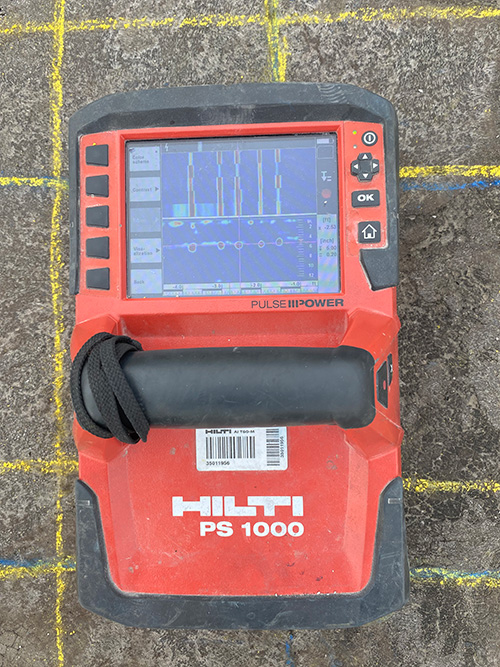Specialist Tips for Optimal Concrete Scanning Outcomes
Specialist Tips for Optimal Concrete Scanning Outcomes
Blog Article
Past the Surface: Leveraging Advanced Concrete Scanning Techniques for Unmatched Precision and Insight
In the realm of building and infrastructure upkeep, the quest for precision and thoroughness is endless. Advanced concrete scanning methods have become important tools in this search, supplying a glance below the surface to reveal a world of crucial insights. By harnessing advanced innovations, professionals can reveal anomalies, assess the problem of concrete structures, and make educated choices that shape the course of jobs. The ramifications of these methods expand far beyond plain surface-level examinations, guaranteeing a deepness of accuracy and understanding that is unparalleled.
Value of Advanced Concrete Scanning
The value of making use of innovative concrete scanning methods hinges on the unrivaled precision they use for finding sub-surface abnormalities and making sure structural honesty. By employing advanced technologies such as ground-penetrating radar (GPR), electromagnetic induction, and progressed sonar imaging, building experts can delve beneath the surface of concrete structures with a degree of precision that much goes beyond traditional evaluation methods. Concrete Scanning. These strategies make it possible for the recognition of surprise dangers like rebar rust, gaps, channels, or post-tension cable televisions that might jeopardize the stability and safety and security of a structure with time
Furthermore, progressed concrete scanning offers invaluable insights into the general condition of a concrete element without the demand for intrusive steps, lessening the risk of creating damages throughout the assessment procedure. The capacity to determine the specific location and depth of prospective concerns enables for targeted fixings and maintenance, eventually prolonging the lifespan of the framework and enhancing its performance. Fundamentally, the relevance of advanced concrete scanning can not be overemphasized in the realm of building and construction and facilities maintenance, where accuracy and integrity are vital.
Types of Cutting-Edge Technologies

Abnormalities and Issue Detection

In addition to GPR, concrete scanning techniques like thermography and impact-echo screening are additionally reliable in identifying abnormalities and problems. By leveraging these innovative methods, experts can proactively address architectural concerns, making sure the durability and safety of concrete frameworks.
Assessing Concrete Condition
Exactly how can designers accurately examine the condition of concrete frameworks to guarantee their longevity and security? Numerous advanced concrete scanning methods are used for this objective. Ground-penetrating radar (GPR) is generally utilized to examine the inner structure of concrete, finding gaps, cracks, and other anomalies that might compromise its strength.
Additionally, aesthetic inspection remains an essential component of concrete problem analysis. Designers visually analyze the surface area for indicators of wear and tear, such as spalling, splitting, or staining. Incorporating non-destructive screening approaches with aesthetic inspections enables an extensive assessment of concrete condition, enabling engineers to identify potential issues at an More Help early stage and execute timely maintenance or repairs. By leveraging these innovative techniques, designers can make certain the lasting longevity and safety and security of concrete frameworks.
Enhancing Decision-Making Procedures
In the world of facilities management, maximizing decision-making procedures is critical for making certain the efficient upkeep and durability of concrete structures. Boosted decision-making processes in concrete administration involve making use of sophisticated scanning strategies to gather detailed information on the condition of structures. By leveraging technologies such as ground-penetrating radar and 3D imaging, stakeholders can make enlightened decisions pertaining to repair service, basics reinforcement, or replacement techniques.
These progressed scanning techniques give vital insights right into the inner structure of concrete, identifying potential issues such as spaces, cracks, or rust that might not show up on the surface area. This level of thorough information enables aggressive upkeep planning, reducing the threat of structural failures and raising the total life-span of concrete frameworks.
In addition, by including digital documentation and analysis tools into the decision-making process, stakeholders can track the evolution of concrete conditions gradually, enabling predictive maintenance techniques and enhancing resource allotment. Eventually, the combination of sophisticated concrete scanning strategies enhances decision-making processes by providing unmatched accuracy, understanding, and performance in infrastructure monitoring.
Conclusion
Finally, progressed concrete scanning strategies supply exceptional accuracy and insight in spotting anomalies, defects, and evaluating the condition of concrete frameworks. By leveraging cutting-edge modern technologies, decision-making procedures can be improved, resulting in even more reliable and informed services for maintaining and repairing concrete infrastructure. These techniques play an important role in making sure the safety and long life of concrete structures, making them try this out a vital tool in the area of building and design.
Additionally, advanced concrete scanning gives vital insights right into the overall problem of a concrete element without the requirement for invasive actions, decreasing the risk of creating damage throughout the assessment process - Concrete Scanning. One more innovative modern technology is 3D X-ray scanning, which offers thorough images of the interior framework of concrete, providing beneficial information without the requirement for devastating screening. Additionally, Concrete Cover Meters are utilized to gauge the thickness of concrete cover over reinforcement bars properly. Enhanced decision-making processes in concrete monitoring entail using advanced scanning techniques to collect thorough data on the condition of frameworks.In verdict, advanced concrete scanning techniques provide unmatched accuracy and insight in finding abnormalities, defects, and examining the problem of concrete structures
Report this page